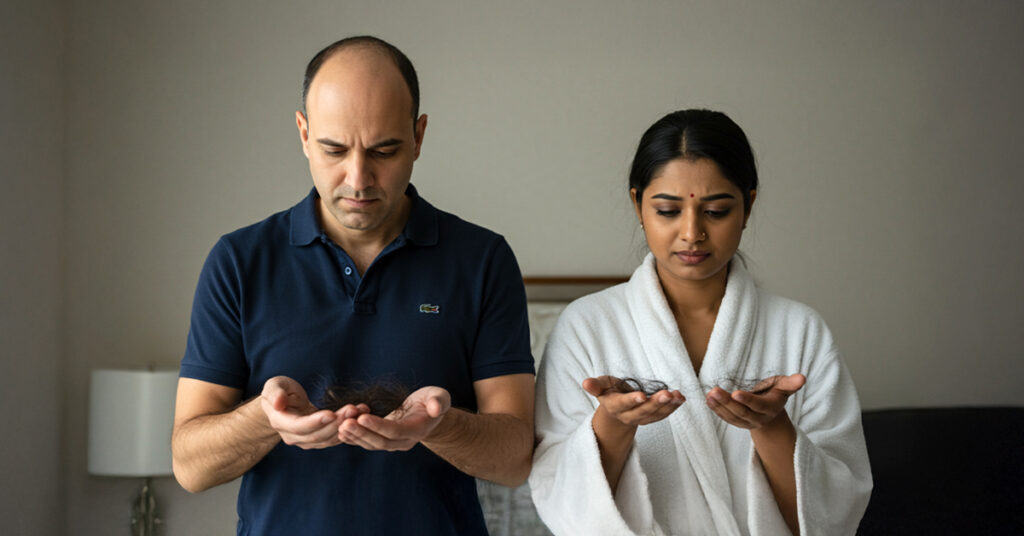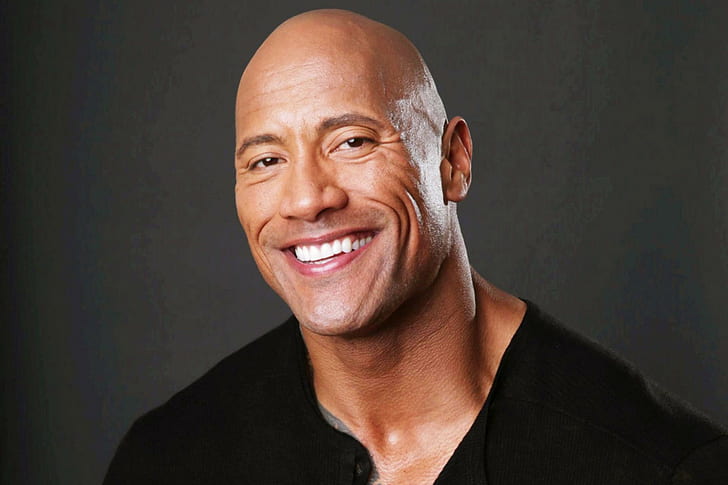In this Article
Hair Loss in Men and Women: The Basics
Hair Loss in Men: The Usual Suspects
Causes of Male Pattern Baldness
Treatment Options for Male Hair Loss
Hair Loss in Women: A Different Beast
Causes of Female Pattern Hair Loss
Treatment for Female Hair Loss
Common Ground for Both the genders
Male and Female Hair Loss: Key Differences and Treatments


Reviewed by Dr. Harsha Sarawgi
MBBS, MD in Dermatology, Venerelogy & Leprosy
Updated on: March 10, 2025
Hair Loss in Men and Women: The Basics
Let’s Face It: Hair Loss is a Universal Concern.
Whether you’re a man noticing a receding hairline or a woman spotting thinning locks, the emotional toll can be significant. But here’s the kicker—male and female hair loss aren’t the same. The patterns, causes, and treatments vary significantly, and understanding these nuances can make all the difference in finding a solution that works for you.
Ready to unravel this Hairy Mystery?
Let’s dive in!
Before we get into the nitty-gritty, let’s cover some groundwork. Hair loss—scientifically known as Alopecia—affects millions worldwide. For men, the usual suspect is male pattern baldness, formally called Androgenetic Alopecia. Women, on the other hand, often deal with a broader range of issues like hormonal imbalances, stress, or even hairstyles that put too much tension on their tresses.
While men might notice a receding hairline or thinning at the crown, women usually experience diffuse thinning all over the scalp. Think of it like losing socks in the laundry: For men, it’s as if an entire drawer of socks disappears. For women, it’s one sock here, another there, until the whole collection feels suspiciously light.
Hair Loss in Men and Women: The Basics
Ah, the infamous male pattern baldness—an unwelcome guest for many. Officially known as androgenetic alopecia, it’s the most common type of male hair loss, affecting up to 70% of men at some point in their lives. The hallmark sign? That receding hairline that slowly morphs into a horseshoe-shaped pattern of hair around the crown. Classic, but not exactly what anyone hopes for.
Causes of Male Pattern Bladness

Blame it on your genes and hormones. Male pattern baldness is primarily caused by a sensitivity to dihydrotestosterone (DHT), a derivative of testosterone. Here’s how it works: DHT shrinks hair follicles, making it harder for new hair to grow. Over time, this leads to thinner and shorter strands until the follicles stop producing hair altogether. Talk about a bad hair day that lasts for years!
Other factors like stress, poor nutrition, and certain medical conditions can exacerbate hair loss in men, but DHT is usually the main culprit.
Treatment Options For Male Hair Loss
The good news? Science has your back. Here are some effective treatments:
Minoxidil: A topical treatment that stimulates hair growth. Bonus: It’s available over the counter.
Finasteride: An oral medication that reduces DHT levels. A doctor’s prescription is required, though.
Follicular Unit Transplantation (FUT) or Follicular Unit Extraction (FUE) can restore your hairline,
though these are more invasive and pricey options.
Improving your Diet, Managing Stress, and Avoiding Harsh Hair Treatments can help slow down hair loss.
Hair Loss in Women: A Different Beast

For women, hair loss is less about receding hairlines and more about overall thinning. Female pattern hair loss, the female counterpart to androgenetic alopecia, affects about 40% of women by the age of 50. Unlike men, women rarely go completely bald—but that doesn’t make it any less distressing.
Causes of Female Pattern Hair Loss
Hormones play a big role here, too. Estrogen helps keep hair in its growth phase, but when estrogen levels drop—like during menopause—female hair loss often kicks in. Other culprits include:
- Genetics: If your mom or grandmother had thin hair, you’re more likely to experience it.
- Medical Conditions: Conditions like polycystic ovary syndrome (PCOS) or thyroid disorders can lead to hair thinning.
- Stress and Lifestyle: High stress, poor diet, and over-styling can wreak havoc on your locks.
Treatment for Female Hair Loss
Women have their own set of solutions to combat female pattern baldness:
Minoxidil: Yes, it works for women too! Look for a 2% or 5% formula.
Birth control pills or hormone replacement therapy can help balance hormones and reduce hair loss in some women.
Supplements like Biotin, Iron, and Zinc can support hair health.
Don’t forget a balanced diet rich in leafy greens, nuts, and lean proteins.
Devices like Laser Combs or Caps can stimulate hair follicles and promote growth.
In rare cases, women experience a male form of baldness (a receding hairline or crown thinning). Treatments like Finasteride are sometimes prescribed off-label for women but require careful medical supervision.
Lifestyle Tips for Men & Women for Hair Loss Management
- 1. Stress Management: Chronic stress is like kryptonite for hair. Yoga, meditation, or even just taking a deep breath can work wonders.
- 2. Healthy Diet: Your hair loves protein, omega-3 fatty acids, and leafy greens. Basically, eat like you’re on a health magazine cover.
- 3. Avoid Overstyling: Heat tools, harsh chemicals, and tight hairstyles are not your friends. Treat your hair like a prized possession, not a science experiment.
- 4. Regular Check-Ups: Hair loss in men and women can sometimes signal underlying health conditions. If the hair loss feels sudden or extreme, it’s time to consult a doctor.
The Social Shift: Breaking Stigmas

The good news?
Conversations about hair loss are becoming less taboo. Celebrities, influencers, and everyday folks are sharing their stories, rocking wigs, or proudly showing off their bald heads. The more we normalize it, the less isolating it feels.
For example, Dwayne “The Rock” Johnson and Jada Pinkett Smith have openly embraced their journeys, proving that hair loss doesn’t diminish star power. It’s a reminder that confidence shines brighter than any hairstyle.
When to Consult a Doctor
If you’ve tried over-the-counter treatments and lifestyle changes but your hair loss persists, it might be time to seek professional help. Hair loss can sometimes indicate underlying issues like thyroid imbalances, autoimmune diseases, or nutrient deficiencies. Consulting a dermatologist can help you pinpoint the root cause and create a tailored treatment plan.
Looking for expert care? Wizderm Skin and Hair Clinic, a leading dermatology clinic, specializes in treating hair loss in men and women. With advanced diagnostics and personalized care, they’ll help you regain not just your hair but your confidence. Book an appointment today.
Final Thoughts
Hair loss in men and women may differ in cause and treatment, but the emotional journey is something we all can empathize with. Whether you’re battling thinning strands or embracing a shiny dome, remember: Hair doesn’t define you. What matters is how you carry yourself—with or without it.
So here’s to keeping your head held high—and whether it’s covered in hair, a hat, or just a generous dose of sunscreen, may it always be fabulous.
FAQs
What are the main causes of hair loss in men and women?
For men, hair loss is most commonly caused by androgenetic alopecia, also known as male pattern baldness. This is linked to genetics and hormones like DHT (dihydrotestosterone).
For women, the causes are more varied, including hormonal changes (e.g., pregnancy, menopause), stress, nutritional deficiencies, and certain hairstyles that stress the scalp.
How can I tell if my hair loss is normal or something to worry about?
It’s normal to lose 50–100 hairs per day. However, if you notice sudden, excessive shedding, patchy bald spots, or a receding hairline, it’s worth consulting a dermatologist to rule out underlying conditions.
Are treatments like Minoxidil and Finasteride effective?
Yes, Minoxidil is a topical treatment approved for both men and women to stimulate hair growth. Finasteride is an oral medication effective for men, as it targets DHT. Women should avoid Finasteride unless explicitly advised by a doctor.
Can lifestyle changes really prevent hair loss?
While lifestyle changes may not completely stop hereditary hair loss, they can slow its progression. Eating a nutrient-rich diet, managing stress, avoiding excessive heat styling, and practicing proper scalp care can make a noticeable difference.
What should I do if over-the-counter treatments don’t work?
If OTC treatments don’t yield results, consult a dermatologist. They can diagnose the root cause of your hair loss and suggest advanced options like prescription medications, low-level laser therapy, or even hair transplants.



